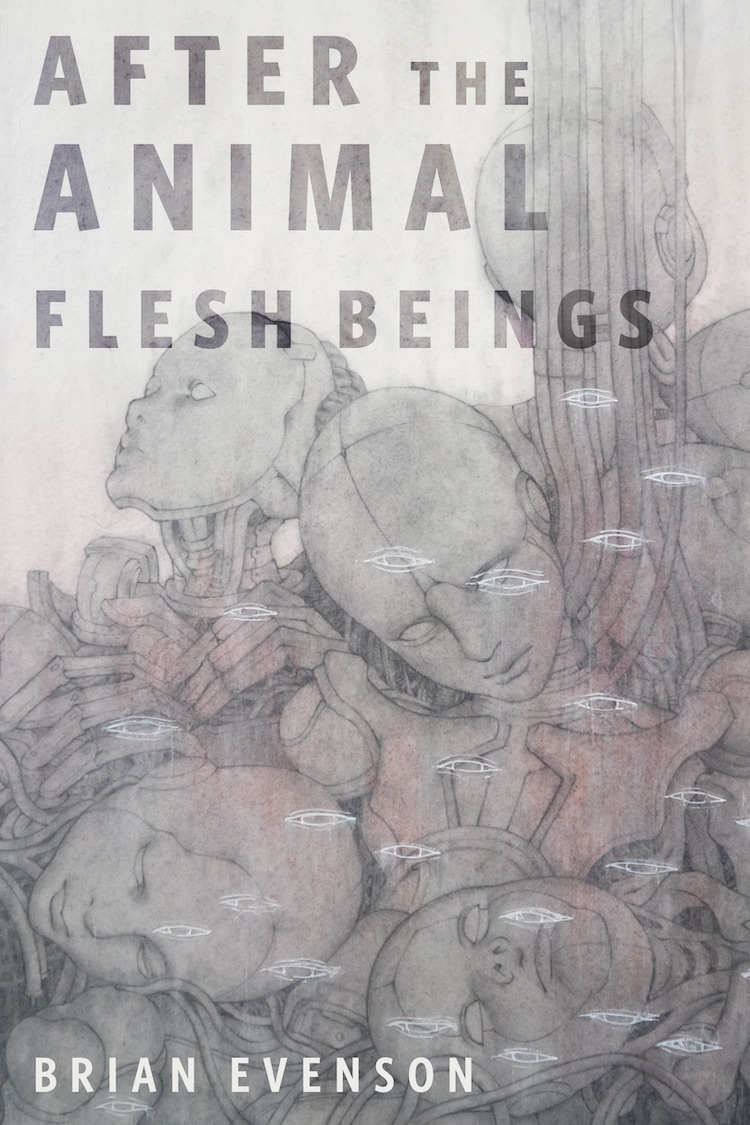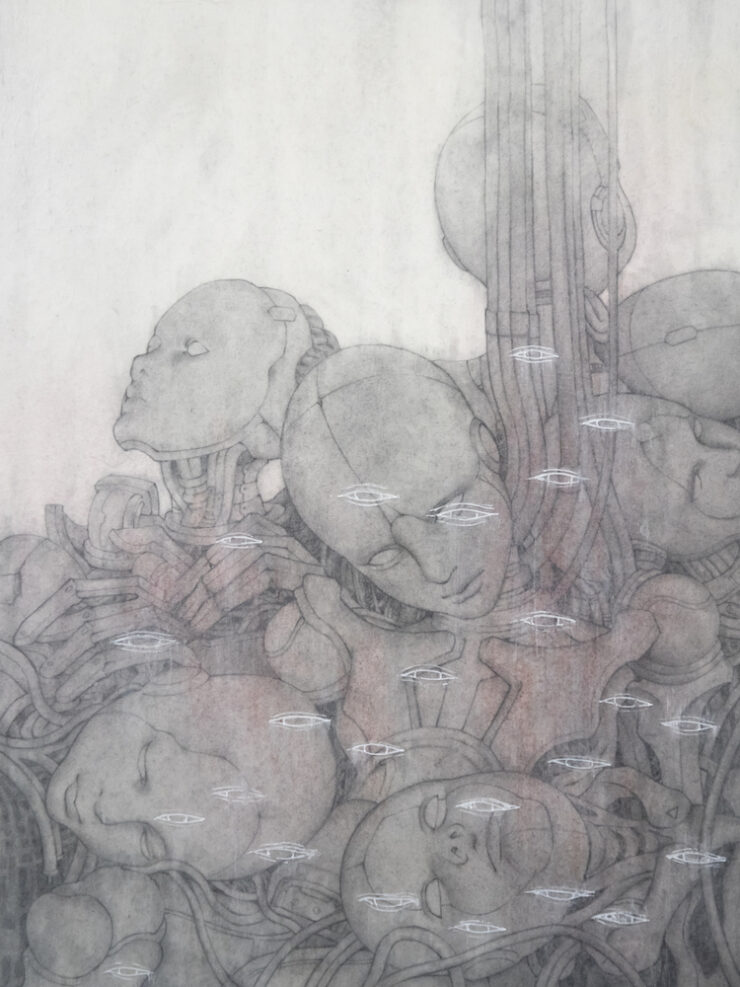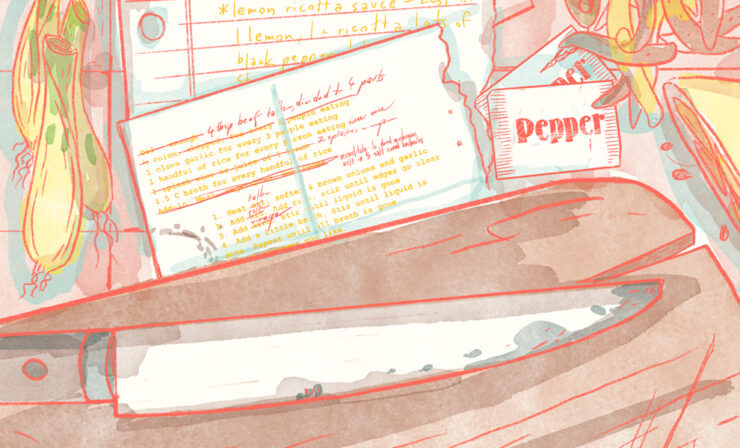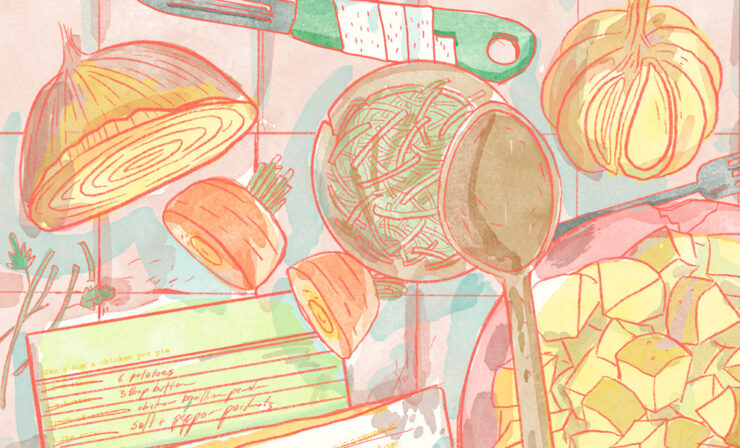A post-human civilization of synthetic beings, fixated on the concept of children, grapples with the meaning of life…after life ceases to exist.
Five Tales
1. How We Acquire Our Children
In the time in which we now find ourselves, we acquire our children by digging in the earth. This is hard work, much harder than the way the scattered records we are still capable of interpreting suggest it used to be done for the animal flesh beings. In the time in which we now live, we dig through soft rock and clay and heap this up, delving deeper and deeper in search of something harder, more substantial. When we find it, we tear it out of the earth the best we can and haul it to god.
God will examine our find and consider, and then say one of two things. He might say, “Yes, this can serve as the basis for a child.” Or he might say, “Why do you bring me this?”
If it can serve as the basis for a child, god will tell us what else is required to bring the child to life. We might spend a month or two, sometimes far more, scavenging in the lost city, searching for the remaining components that will make a child. Indeed, ranged to one side of the smelter is a long line of children who are not yet alive and who, for lack of components, may well never be. Their shining bodies stand gaping, split neatly open, waiting to be filled with functional components and brought to life.
It is a joy to watch god work. He brings his pitted, expressionless face close to the fire as the hunk of child grows hot and begins to glow. At just the right moment, god reaches in, carefully, and deftly extracts a portion of the hunk with his fire-blackened digits. He sets about hollowing and working and shaping this, then does another hunk, then another. Later, he will establish joints and connections between them. Eventually, if we are lucky, we have something made to resemble us, but smaller: a child.
Children are always smaller than us. Sometimes they are only a dozen centimeters shorter. Other times they are just a half meter tall. They do not grow—although the records seem to suggest that children once did grow. Perhaps, though, the records’ use of “growth” is only metaphorical, not literal.
Our children do not speak, and cannot hear. They can see, usually, and often do respond to gestures. They can be taught simple tasks. They move and walk, but with little of the fluidity with which an adult is imbued. Having been snatched back from the embrace of death, they move jerkily, as if in spasms. Nor do they live nearly as long as we do. Many generations of children we have created might well pass away before we succumb to death ourselves.
In the times before god, in the times before time began, rumor has it that the animal flesh beings who used to inhabit the lost city built large structures in which hundreds of our children could be made at once, piece after piece, child after child. It was, so it is said, much faster. It is rumored that we are those children.
Why did these animal flesh beings make us? Did they think of us as their children, despite our being made of a different substance entirely? Did they have another purpose for us?
With their records mostly decayed or unreadable, we can only speculate.
There are those who believe we were once those animal flesh beings but that, as more and more gleaming children were made, we became such deft mimics as to become gleaming beings ourselves, so as to better resemble our children, so as to blend in.
There are also those who believe that these animal flesh beings made extraordinary vessels and in them fled to the skies. Being made of animal flesh, they believed they had to keep consuming animals in order to replenish their bodies. Eventually, voracious, they consumed every animal. They left for the skies in search of more. Perhaps, some think, they will return some day and build again their large structures for making children, and we will once again have children as large as us and that last as long as we do. But most feel this to be a vain hope.
2. The Malformed Child
In the final days of god’s usefulness, as he became less and less himself, he fashioned a malformed child. In the past, whenever he took a false step, god would pause and scrutinize his work. If he found it wanting, he would lift up the potential child and deposit it back in the flames, melting it down to begin again. In the final days of god’s usefulness, however, god’s judgment failed him.
After he had shaped it, the malformed child had one arm too long and one arm too short. It had one leg too short and one leg too long. The child had only one lens, and this lens was cracked. No doubt the child saw the world through it as would an insect through its compound eye, if there were still insects.
God lifted the child and peered at its broken right lens and then at the absence of the place where the other should be. We waited and watched for god to cast it back into the fire. But after a long moment, god nodded his head and set it gently down, its casing split open and awaiting components.
“Go,” he said to the parent-to-be for whom he had fashioned the child. And then god told the parent-to-be what components were needed for the child to be complete.
Some of us were surprised that this parent-to-be left for the lost city, that he searched for what was needed, that he eventually found everything, that he eventually came back. But perhaps, unlike us, he suspected this child would be the last one god would make. Or perhaps he believed god would eventually recognize how malformed the child was and would reshape it while he was gone.
In any case, the parent-to-be came back months later, his hands full of what he had found, and offered it to god. For a moment god remained motionless and then, groaning, he lurched back to life and completed the child.
As for the malformed child, it did indeed come to life, but every time it tried to take a step it would lose its balance and fall over. It would struggle up, take another step, again fall. In the end, its parent prevented it from struggling to its feet and with great effort and patience taught it how to crawl. It still moved awkwardly and jerkily, even for a child, but at least now it could travel from place to place. Its parent tried to teach it other things as well, but the malformed child seemed incapable of learning anything beyond crawling.
Its parent eventually took the malformed child into the forest and abandoned it. It found its way back home. He abandoned it in the forest again, but no matter how many times he did this the child always managed to find its way back home. Why did the parent not simply disable it? Why did he not stoke the furnace again and thrust it in? We don’t know. All we know is that he didn’t.
One day we awoke to discover that the parent had ended himself. There he was, hanging from the ceiling, gently swaying, his components torn out by his own appendages and dangling in strings around his waist. The malformed child crawled in circles on the floor beneath him.
We came to the door and watched them, the parent’s gleaming feet swaying back and forth, sometimes brushing the child’s head. The child, oblivious, crawled and crawled. The sight was terrible to behold.
And so, so as not to behold it, we closed the door.
None have set foot in that house since. For all we know the child is there still, crawling, crawling, as its parent sways gently above it.
3. An Animal Flesh Times Story
This is a story from the time of animal flesh beings. It is one of the oldest stories we know. Perhaps it is our very oldest. It was read by one of us in a record that fell to dust even as it was read, and then repeated from one mouth to another, and now it comes to me to transcribe it and, in these waning days of our existence, leave a record of it for whatever beings come after us.
A woman wanted a child. The god in those days was unlike the god we used to have before god went wrong. No, this god was airy and perverse. He did, it is true, give this woman a child after she begged him, but only on condition that she never look at it. She would have to keep it at home and never leave home herself. Did she agree to such conditions? She did, because of how much she desired a child.
She gathered enough food for several years and filled her dwelling with it. She took hold of the hem of her raiment and tore it, and tore it again, and with her teeth managed to remove a long strip of fabric with which she bound her eyes. Then she said, “I am ready. Bring me my child.”
Her god came as a huge blast of wind and shook the walls of her dwelling and blew her off her feet. When, at last, the air had grown silent again, she felt around on the floor until, at last, her hands discovered her new child.
There was, she should have realized through the senses she still had, something wrong with this child. Its skin was harder than usual, and it was cold to the touch. It moved, true, but it made no sound. Or rather, almost no sound. Whenever she lifted the child up or set the child down, she would hear a click. Quick and singular, not repeated, but she was sure she heard it.
For many days she was happy with this child, singing to it and rocking it and feeding it. It filled a hole that had been in her heart. True, she no longer could be around other humans, could no longer do anything but spend time with her child. But, for her, that was sufficient.
Until the moment it was not.
Click, she heard. And then, click.
Could this possibly be the noise a child was meant to make? No, it seemed wrong to her. Still, she crooned to her child and held it, but there was an anxiety within her singing now, and while most of her still wanted to hold fast to the child, a portion of her desired to push it away.
After many days that click sounded so loudly in her ears each time she lifted the child up or set the child down that she could no longer bear it. She went to the door flap of her dwelling and stuck her head out. She stayed there, listening, blinded by the strip of cloth around her eyes, until finally she heard footsteps.
“Hello?” she said.
Abruptly the footsteps stopped.
“Is anyone there?” she asked.
A voice responded, an old woman’s voice. “We thought you were dead,” said the old woman’s voice. “When you did not come out of your dwelling, we thought you had died and that your dwelling had become your tomb.” And then, after a long silence in which the woman marveled over what the old woman was telling her, “Are you dead?” asked the old woman.
“I don’t know,” said the woman. She had not looked at herself for many months. And she could remember giving food to the child, but could not for the life of her remember feeding herself. Was she alive?
She shook her head to clear it. No, she must be alive. She was talking, wasn’t she? But even as she tried to convince herself that she was still alive, she became more and more afraid that she wasn’t.
She said to the old woman, “I need you to tell me if anything is wrong with my child.” And she reached behind her and grabbed her child and thrust it out through the door flap of her dwelling for the old woman to see.
There was a long silence. And then, “What child?” asked the old woman. The woman could tell from the sound of the old woman’s voice that she was already some distance removed, that she was slowly backing away. And then she heard the pounding of the old woman’s feet as she began to run.
The woman crawled back into her dwelling. She did not know what to do, but she told herself that if what she had been given was not a baby then she no longer had an obligation not to look at it. Perhaps her god had tricked her. She would, she told herself, take one quick glance at the baby and then, if everything was as it should be, would replace the strip of now filthy cloth around her eyes and never take it off again. Still, she was careful to tie the door flap of her dwelling closed so that her god would not know she had broken her promise.
Very carefully she picked at the knot just at the back of her blindfold. She picked at it and picked at it until the strip of cloth came undone. Then with great care she unwound it and removed it from over her face, and then she opened her eyes.
There before her was a doll. It lay lifeless on the ground, smeared with dried bits of the food she had tried to feed it. Astonished, the woman lifted it up, and as she did so it clicked, as she had often heard it do, and its eyes came open. It looked at her and she realized she had been wrong, that this was not a lifeless thing after all. Just because it was a doll did not also mean it was not a child. It was, she realized, somehow both. It was both alive and not alive. Her god had both tricked her and given her what she wanted, all at once.
When the doll that was also her child gazed upon her, she felt her eyes drip from their sockets. She no longer needed the strip of cloth to not see. And then the child doll dissolved into sand in her hands. Soon all she had was a pile of sand. And, not long after, even that was scattered and the blind woman was alone, left with nothing at all.
4. Oherdluq’s Array
There was one among us named Oherdluq who seemed from the outside to have all the proper circuitry but whose reasoning was, at best, faulty. We did not know this about him, since he looked on the outside just as we all look.
Oherdluq did not have a child and he had never dug for one. But any time he saw a child without a father or mother near it, he would approach that child and coax it back to his dwelling. Once there, he would open the child up and push his digits around inside its casing. If he found any component that he admired, he would tear it out and take it for himself, hiding it in a special and secret place. Then he would close the child up, make it forget what he had stolen from it, and release it bewildered back into the world. Often it would be some days before it became clear from the child’s behavior that something was wrong, and by that time it was impossible to say who or what had meddled with the child. Sometimes, no doubt, the theft was never discovered, the change in the child not even detected.
One day, however, Oherdluq opened a child so filled with desirable components that he could not bring himself to choose just one. He took first one, then another, then yet another, so that when finally the child was closed up it was no longer functional. At first, he tried to return some of the components to it, but no matter how he tried to reconnect them, the child remained still and dark.
In the end, Oherdluq dumped what was left of the child in the forest.
A day later, by accident, the dumped and broken child was found and brought to its father. In his haste and panic, Oherdluq had forgotten to make the child forget what he had done to it, and so when its father removed the most recent memory component and slotted it into his own body, he saw exactly what Oherdluq had done to his child.
The father took the memory component to god and gave it to him. This was back when god was still god, back before he began to fail. God held the component and peered at it and then slotted it into his own body. When he knew exactly what was on it, he took the component out again, and cast it into the furnace.
“Bring Oherdluq,” god said.
And so Oherdluq was found and brought to god, who, without a word, picked him up and cast him deep into his furnace. Each time Oherdluq tried to force his way out, god simply pushed him back in until, at last, Oherdluq was no more.
In most ways this is the end of the story, but in at least one other way the story continues. Many days after Oherdluq met his death, one of us, it does not matter who, stumbled across Oherdluq’s hiding place, the place where he had stored all the components he had torn from children.
It was a cave, deep in the forest. When the one who found it entered and looked closely, he realized that the back wall of the cave was a false wall. It seemed like a solid wall until you came very close indeed. Once you did, you realized that, no, what you had thought to be a simple irregularity in the rock of the wall was a place where one wall passed in front of another wall, obscuring a passage that led further back.
The one who found the truth of this went into this passage and followed it back, pursuing its twists and turns until he came to a deliberately shaped chamber. It was large and circular. In the center was a sort of altar upon which all the components stolen from all the children had been arranged to form a sinister array. They had been connected to form a new being, a new mind, though when he tried to communicate with this being by connecting to it, the only thing he heard was the sound of screaming.
He destroyed the array. He thought it the only merciful thing to do and we, once he told us what he had found and what he had done, couldn’t help but agree. It was, we are almost certain, the only merciful thing.
5. The Death of God
No one knows why god threw himself into the fiery furnace. Some think he did so because he recognized he was reaching the end of his life and was afraid that if he did not destroy himself someone would try to bring him back from the dead. Others that his intention was to melt himself so that someone else could be inspired to become the new god and shape him into a child. Others that it was not a conscious act, that it was simply the flailings of his damaged components.
For a long while god just lay there in the flames, his casing blackening and refusing to melt. But slowly, after some hours, he softened and began to lose his shape. In the end, god became a molten puddle, and then, at last, the fire of the furnace went out and slowly he hardened into a lump.
When what had once been god was cool, we took him and lifted him from the furnace, and then we destroyed the furnace. We carried him far away, and then we dug a hole and buried him deep within the ground. We have had no children since.
Perhaps, some of us told ourselves, someday god would come again, in a new form. And then we would dig up his first self and present it to him. Out of it, out of his old self, so we still try to believe, he would make his first child. And then we could have children again as well.
“After the Animal Flesh Beings” copyright © 2023 by Brian Evenson
Art copyright ©2023 by Reiko Murakami
Buy the Book


After the Animal Flesh Beings














